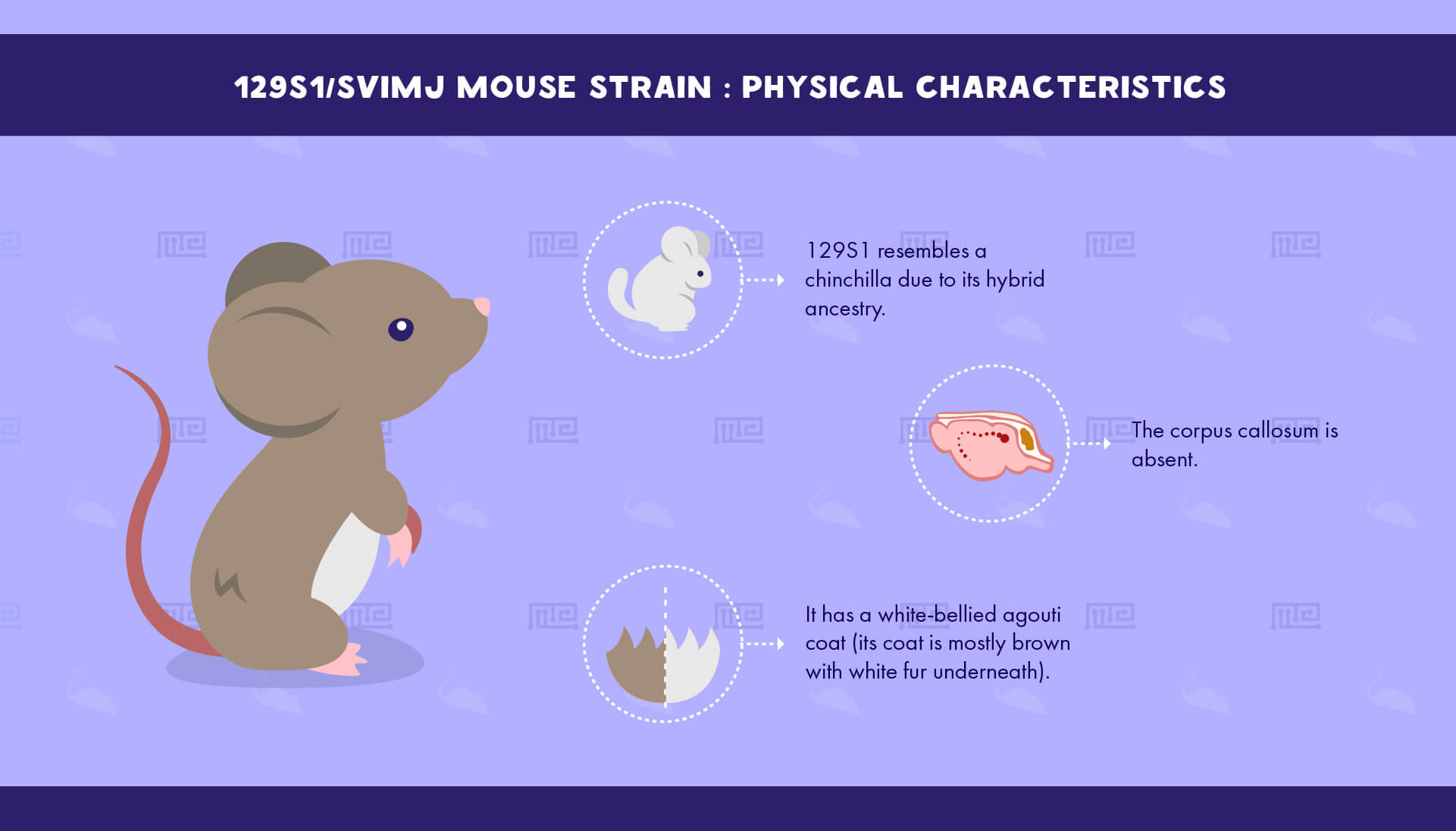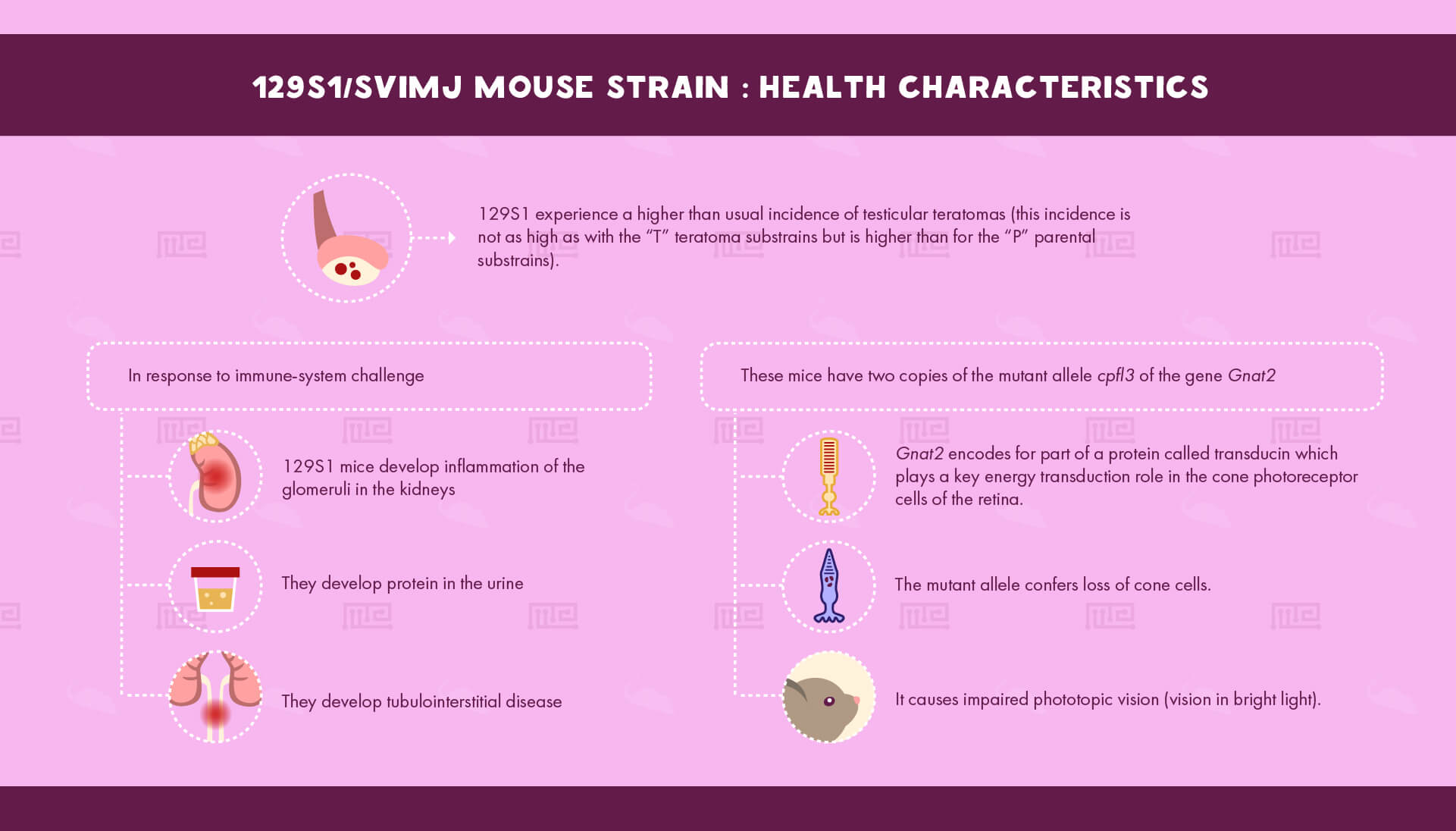Overview
129S1/SvImJ, also known as 129S1, is one of the “steel” substrains of the 129 mouse strain family.[1]
History
All mice in the 129 strain family descend from a cross that was carried out by Dunn in 1928 between English fancier mice and a stock of chinchilla. These 129 mice went from Dunn to Russell in 1945, before passing to Hunt and Wynder and then, finally taken by Runner at the Jackson Laboratory in 1947.[2][3]
129S1, in particular, was developed in the late 1990s in order to act as a control for various embryonic stem cell lines derived from other 129 family mice. It was originally named 129S3 before being renamed 129S1 in 2001.[3]
Physical Characteristics
Like all mice in the 129 family, 129S1 resembles a chinchilla due to its hybrid ancestry. It has the white bellied agouti coat, meaning its coat is mostly brown with white fur underneath.[3] The corpus callosum, a structure linking the two hemispheres of the brain, is absent.[1]
Behavioral Characteristics & Handling
While the Jackson Handbook does not highlight any particular handling difficulties with this strain, 129S1 does seem harder to keep than many other mice. The Handbook states that these mice tend to chew a lot of grain and require more frequent grain replacement, and also that they build up shavings under their water bottle leading to wetness and drowning.[3] Researchers requiring mice that are very easy to keep may not want to choose 129S1.
129S1 has been reported to show deficits in fear generalization and fear extinction. A 2012 study found that, compared to C57BL/6J, 129S1 mice froze more in response to a conditioned context and an ambiguous context in fear conditioning, and showed much slower fear extinction.[4] It thus seems that this strain has an impaired ability to discriminate dangerous from safe stimuli. Further, 129S1 shows high anxiety in the elevated plus maze.[5]
Health Characteristics
As with other 129 strains, 129S1 experience a higher than usual incidence of testicular teratomas. This incidence is not as high as with the “T” teratoma substrains but is higher than for the “P” parental substrains.[1]
In response to immune-system challenge, 129S1 mice develop inflammation of the glomeruli in the kidneys, protein in the urine and tubulointerstitial disease.[1]
They also have two copies of the mutant allele cpfl3 of the gene Gnat2. Gnat2 encodes for part of a protein called transducin which plays a key energy transduction role in the cone photoreceptor cells of the retina. The mutant allele confers loss of cone cells and causes impaired phototopic vision (vision in bright light).[1][6]
Major Experimental Uses
129S1 mice are primarily useful for the generation of embryonic stem cell lines, in particular (as mentioned above) as a control condition for experiments with the other steel substrains in the 129 family.
129S1 can also be applied to research on cancer (especially testicular cancer), visual impairment, autoimmunity, kidney disease, mutagenesis and callosal agenesis.
References
- 002448 – 129S1/SvImJ. 2019. 002448 – 129S1/SvImJ. [ONLINE] Available at: https://www.jax.org/strain/002448. [Accessed 24 September 2019].
- MGI – Inbred Strains: 129. 2019. MGI – Inbred Strains: 129. [ONLINE] Available at: http://www.informatics.jax.org/inbred_strains/mouse/docs/129.shtml. [Accessed 24 September 2019].
- The Jackson Laboratory Handbook on Genetically Standardized Mice. 6th ed. 2009. [ONLINE]. Available at: http://jackson.jax.org/rs/444-BUH-304/images/JAX%20Handbook%20Genetically%20Standardized%20Mice.pdf.
- Camp, M. C., Macpherson, K. P., Lederle, L., Graybeal, C., Gaburro, S., Debrouse, L. M., … Holmes, A. 2012. Genetic strain differences in learned fear inhibition associated with variation in neuroendocrine, autonomic, and amygdala dendritic phenotypes. Neuropsychopharmacology : official publication of the American College of Neuropsychopharmacology, 37(6), 1534–1547.
- Moy, S. S., Nadler, J. J., Young, N. B., Perez, A., Holloway, L. P., Barbaro, R. P., … Crawley, J. N. 2007. Mouse behavioral tasks relevant to autism: phenotypes of 10 inbred strains. Behavioural brain research, 176(1), 4–20.
- Genetics Home Reference. 2019. GNAT2 gene – Genetics Home Reference – NIH. [ONLINE] Available at: https://ghr.nlm.nih.gov/gene/GNAT2. [Accessed 24 September 2019].


